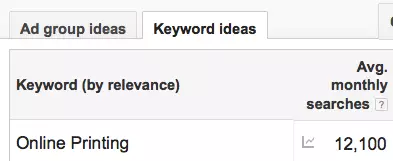The point is that the retail consumer is searching for ‘online printers’ with the resultant listing of retail print stores, while a ‘web-to-print’ search turns a list of W2P software developers.
According to Milap Shah, director at PrintStop, which runs a retail printing outlet, web-to-print is a technical term and is not relevant for the end customer. “The end customer is concerned with printing products (visiting cards, envelopes etc). He/she doesnt care whether the technology is called web-to-print or direct print from internet.”
And hence, online printing is what the customer will search for and where they will see actual printing companies or online stores fronting as printing companies.
But in those searches, there’s no trace of those offset and digital print service providers which have online presence.
My guess is that most printing companies who have a website don’t necessarily have a transaction-able website. The website is more to get leads and then convert them and to showcase their clients, infrastructure etc. These websites will not be optimised for SEO and also these websites will not be spending money on Google Ads
Milap Shah, PrintStop
The online transaction-able printing companies on the other hand optimise their pages for SEO for those relevant keywords and also do Google CPC Ads. These companies would be a mix of actual printing companies and companies who take orders and get their printing outsourced.
Retail printing: whose domain?
So the question is: Will retail printing business be done by non-printing software companies? From the looks of it, that seems the way. But successfully running a retail business requires a different skill set in non-printing areas, for example, strong logistics and software development, which most print companies do not have.
“Software companies will develop the portal, manage the logistics, etc., and get the print done from conventional printing presses,” says Prithviraj Desai, director at Mumbai’s Mail Order Solutions (MOS).
It is a good opportunity for those presses that do not have a skill set to manage online business. They can get a piece of this pie by collaborating in a strategic manner with such companies to grow their business
Prithviraj Desai, MOS
Delivering online services require a very solid platform, and a seamless workflow. The user interface, the back-end necessary to execute the job as per specs, the logistics involved to deliver the product on time is much more critical than running a printer. “A non-print company, in my opinion can be more successful in running such a business compared to ‘traditional print house’,” says Manu Choudhary, director at Kolkata’s CDC Printers.
Both Desai and Choudhary share the classic example of Ola and Uber taxi services. Their business model is based on development of systems rather than running a taxi company. For them running a taxi company is a part of their system, which can be delegated.
“For a traditional printer, our focus is mostly on print production. We develop systems to improve our print production. They start with systems in which print production would only be a module that can be outsourced,” they say.
W2P: to capture retain print market?
But can’t print companies capture retail print market using web-to-print? Given the example of Ola and Uber, Mega Cabs are trying their best to be at par with the two.
Of course print companies can capture retail print market using web-to-print. But for a print company to be successful in capturing retail print, they need to think more like technologists rather than printers. Once they start thinking in this direction, they would no longer be classified as traditional print company.
Manu Choudhary, CDC Printers
Desai feels that conventional printing companies must look to collaborate and co-create rather than venture on their own. “The percentage chances for success will increase due to this. You must always play to your strengths.”
Milap Shah of PrintStop however, feels that retail print business is definitely not for everyone because getting a W2P solution is just one step, there is a need to set up the complete eco system right from customer service, marketing, logistics, packaging etc. So companies need to do their research properly and be ready for the long haul. “People make the mistake of assuming that once we get a web-to-print solution, it opens up an alternate channel and orders will start flowing. Also large printers might not be able to handle small orders ranging from Rs 200 to Rs 1,000 per order. And if the customer is upset then handle their rants on social media.”
Manoj Kotak of Flexi Web2Print, a W2P solutions provider, says technically a printing company can now have a multiple web to print solution for as low a monthly fee of Rs.10,000. “But as Shah points out, promoting retail venture involves lot of cost,” he says.
W2P: additional investment or incremental expense?
A question arises, if not for running an online print store, can W2P be a tool to engage existing customers?
Kotak says, there are few hurdles starting with a W2P solution, and that’s what keeping the print company away. “But they are not aware of the fact that a new customer base is building up who is first trying small online printing order, keep adding more volumes and then becomes habitual to online printing.” Kotak says, printers catering to retail commercial printing need to start thinking of these facts too.
But Choudhary, whose print company is in the commercial line of print too, had thought of starting a W2P service but realised that his company’s thought process is not suited yet for offering this kind of services. He says, “A tool to engage our existing customers would not be retail printing. We are developing an online portal for our customers where they can browse order history, submit new jobs, check job status etc. But this would not be classified into retail printing.”
Speaking for MOS, Desai, says, we are too much of a niche player. “We do have the capabilities to set up a webstore and run it as we have a very strong software team and excellent logistics network, but retail is not our focus area.”
The challenges
Certainly, starting something in web-to-print wouldn’t be too challenging for print companies, but having an understanding of retail business is also important. Once you are into this space and doing business, the next challenge would be to bring the same customer back to the portal for repeat purchases through direct marketing campaigns.
The existing ready-made W2P solutions are not enough to be a successful W2P solution provider nationally. There are several templates available online to set up an 'online shopping store'. They would look as good as Flipkart. One can use those templates and probably have a running web portal in less than a month’s time. But that would not make one Flipkart
Manu Choudhary, CDC Printers
And it is not just about sending mailers but engaging the customer. The customer is very fickle and one must have a programme to get repeat business. “For that, you need data analytics, which is another ball game all together, says Desai of MOS.
Shah of PrintStop says, as a culture we are lazy people and if I am getting the convenience of ordering from my office/home, why should I get out.
While using web-to-print technology that help offer printing services online that can add value to their clients, it can open a window of opportunities and generate new orders from unknown first time customers. So, at least for now, and until the print companies are willing to go that extra mile, it looks like the online retail printing business will remain in the realm of few digital printers and non-printing software companies.














 See All
See All